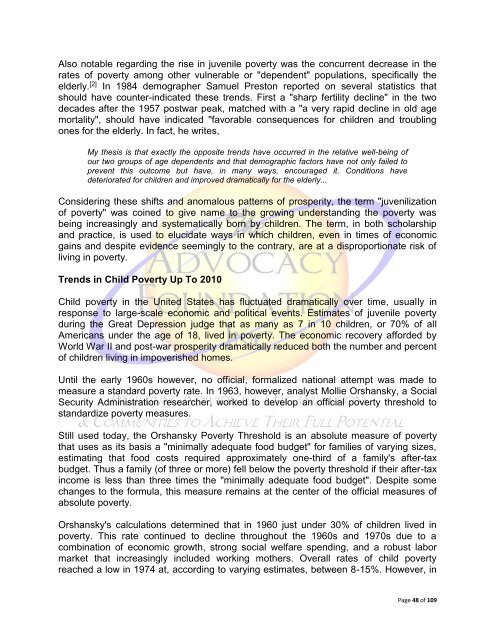Children of Incarcerated Parents
Children of Incarcerated Parents
Children of Incarcerated Parents
Create successful ePaper yourself
Turn your PDF publications into a flip-book with our unique Google optimized e-Paper software.
Also notable regarding the rise in juvenile poverty was the concurrent decrease in the<br />
rates <strong>of</strong> poverty among other vulnerable or "dependent" populations, specifically the<br />
elderly. [2] In 1984 demographer Samuel Preston reported on several statistics that<br />
should have counter-indicated these trends. First a "sharp fertility decline" in the two<br />
decades after the 1957 postwar peak, matched with a "a very rapid decline in old age<br />
mortality", should have indicated "favorable consequences for children and troubling<br />
ones for the elderly. In fact, he writes,<br />
My thesis is that exactly the opposite trends have occurred in the relative well-being <strong>of</strong><br />
our two groups <strong>of</strong> age dependents and that demographic factors have not only failed to<br />
prevent this outcome but have, in many ways, encouraged it. Conditions have<br />
deteriorated for children and improved dramatically for the elderly...<br />
Considering these shifts and anomalous patterns <strong>of</strong> prosperity, the term "juvenilization<br />
<strong>of</strong> poverty" was coined to give name to the growing understanding the poverty was<br />
being increasingly and systematically born by children. The term, in both scholarship<br />
and practice, is used to elucidate ways in which children, even in times <strong>of</strong> economic<br />
gains and despite evidence seemingly to the contrary, are at a disproportionate risk <strong>of</strong><br />
living in poverty.<br />
Trends in Child Poverty Up To 2010<br />
Child poverty in the United States has fluctuated dramatically over time, usually in<br />
response to large-scale economic and political events. Estimates <strong>of</strong> juvenile poverty<br />
during the Great Depression judge that as many as 7 in 10 children, or 70% <strong>of</strong> all<br />
Americans under the age <strong>of</strong> 18, lived in poverty. The economic recovery afforded by<br />
World War II and post-war prosperity dramatically reduced both the number and percent<br />
<strong>of</strong> children living in impoverished homes.<br />
Until the early 1960s however, no <strong>of</strong>ficial, formalized national attempt was made to<br />
measure a standard poverty rate. In 1963, however, analyst Mollie Orshansky, a Social<br />
Security Administration researcher, worked to develop an <strong>of</strong>ficial poverty threshold to<br />
standardize poverty measures.<br />
Still used today, the Orshansky Poverty Threshold is an absolute measure <strong>of</strong> poverty<br />
that uses as its basis a "minimally adequate food budget" for families <strong>of</strong> varying sizes,<br />
estimating that food costs required approximately one-third <strong>of</strong> a family's after-tax<br />
budget. Thus a family (<strong>of</strong> three or more) fell below the poverty threshold if their after-tax<br />
income is less than three times the "minimally adequate food budget". Despite some<br />
changes to the formula, this measure remains at the center <strong>of</strong> the <strong>of</strong>ficial measures <strong>of</strong><br />
absolute poverty.<br />
Orshansky's calculations determined that in 1960 just under 30% <strong>of</strong> children lived in<br />
poverty. This rate continued to decline throughout the 1960s and 1970s due to a<br />
combination <strong>of</strong> economic growth, strong social welfare spending, and a robust labor<br />
market that increasingly included working mothers. Overall rates <strong>of</strong> child poverty<br />
reached a low in 1974 at, according to varying estimates, between 8-15%. However, in<br />
Page 48 <strong>of</strong> 109

















